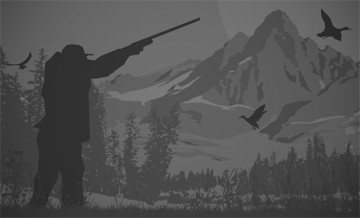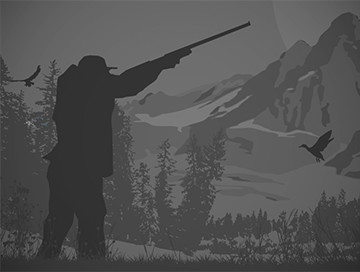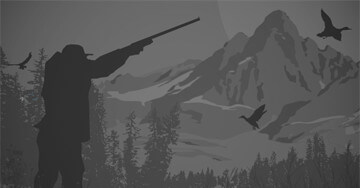Baiting on map
About Baiting
Different situations require different actions. Sometimes terrain, thick vegetation or even the elusiveness of your prey dictate using alternative methods to the default way of spot and stalk. If you can't approach the animal, you can lure the animal to come to you. Baiting is one of the ways to do it - place some attractant where you want the animal to come to, and wait for it to appear. Sounds simple, but, like many other apparently simple hunting schemes, it has its share of complications and dire straights. Read more...
Waiting for your quarry to come to you is an ancient tradition that comes in many forms and shapes. Baiting is distinguished by the fact that the food that you attract the animal with is laid deliberately. However, the line between artificial bait and a natural food source is very thin. A prime example of this is bear hunting over oat fields in Russia. Some of these fields belong to local farmers, who expect to make a profit out of the oats. Others are planted by outfitters solely as attraction for bears and wild pigs, and aren't even meant to be reaped. From your tree stand, you'll never know the difference. As long as it’s legal, any food that is attractive to a particular animal can be used as bait, and numerous ways of placing it are possible. Bear treats, for example, include expired human foodstuffs such as hot dogs and confectionary. In some places, e.g. hunting sitatunga in a number of African countries, food sources are created by burning patches of the jungle. Fresh grass that grows over the burns attracts the animals. Baiting is perhaps the most common method of taking the big cats in Africa. This hunt is usually integrated into the general scheme of the safari, when the client first hunts the herbivores, and then the meat of these animals is used as bait for a lion or a leopard. Normally, the PH and the crew set up a number of baits, in the places where a huntable animal was seen, or its tracks found. Then the team may spend day after day driving from bait to bait, until it discovers that one of them has been discovered by a legal trophy. This is determined by reading tracks and other signs left by the animal, or watching images from trail cameras placed at the bait. When the answer is positive, a ground blind or a tree stand is constructed, and the hunter with the PH stay to wait for the animal. This hunt may prove not as tame as it seems, especially when hunting from a ground blind. When meat is the attraction, the predator may find the lure of fresh meat of the humans more attractive than old one on the bait, and hunt the hunters. Predators who consider the bait their property are naturally defensive, and the approach to the blind can become an unpleasant surprise. Where and how to lay the bait is the guide's responsibility, and the hunter seldom has a say in the matter. Positioning the baits is a problem with many variables. The place where the bait is laid should be not only lie where the animal has a good chance of finding it, it must be convenient for the hunter positioning the animal in a good shooting position when feeding, but also be convincing and give the appearance of safety for the animal. To achieve this, guides occasionally resort to “advertising” - for example, dragging a piece of bait behind the truck for a long distance, leaving a scent trail to the main course. Still, on many occasions a hunter has to wait for days before the desired trophy discovers and begins feeding on the bait at the right time or during legal shooting hours. Once the animal finds the bait, a different problem often occurs: how to keep it there long enough. When a predator finds an attractive meal in the open, it instinctively tries to drag it into an enclosed spot, to hide and/or consume without being disturbed. This, of course, works against the main purpose of the hunt, and creates the need to invent something to force the animals to eat the treat on the spot. Black bear hunters in the USA, for instance, place the bait in metal drums and tie them to trees. African PHs hang pieces of meat as bait for the big cats just high enough in the trees to catch their interest and give them a taste but yet not let them gorge themselves and get full and also out of reach of other scavengers who would deplete the bait. The biggest challenge with hunting over bait is that in 9 cases out of 10, the animal comes to the bait at dusk or dawn, in twilight, or even in the dead of the night. Even with modern optics, shooting when there's not enough light can be a challenge. Technology can help, but different nations and regions have different regulations regarding legal shooting hours, use of night vision sights and artificial light. It's better to check out the rules in advance, to know where you stand. In other respects, hunting over a bait differs little from other cases of hunting from a blind or a high seat. You should be as careful, silent and motionless in this instance as in other instances when you wait for the animal to come to you. The main advantages are equally similar. Additional food source attracts not only the intended quarry, and you can become a witness to the most intimate scenes from the life of nature. One hunter, while waiting for a Himalayan bear in the Primorie region of Russia, had a fortunate if not disturbing experience when a Siberian tiger with cubs came to the bait. Baiting is usually the means of last resort, used when nothing else is possible. But that doesn’t mean it’s not an exciting pursuit, and it usually makes for very intimate encounters with nature. Discover your baiting options on BookYourHunt. Hide details
Interested in Baiting trips? Create a subscription to get offers right to your inbox




